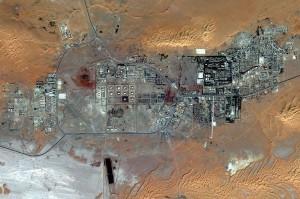 The attack on the Algerian gas plant near In Amenas on February 16th has left at least 37 hostages dead in another example of terrorist organizations targeting energy systems. The tragic loss of life of gas field workers along with the nagging reminder of threats against energy infrastructure will add this attack to a list of other attacks carried out by Al Qaeda with the intent to harm the United States and other Western countries.
The attack on the Algerian gas plant near In Amenas on February 16th has left at least 37 hostages dead in another example of terrorist organizations targeting energy systems. The tragic loss of life of gas field workers along with the nagging reminder of threats against energy infrastructure will add this attack to a list of other attacks carried out by Al Qaeda with the intent to harm the United States and other Western countries.
Reports of the incident have been scattered and conflicting over the last few days, but it appears that a veteran jihadist named Mokhtar Belmokhtar carried out the attacks in the name of Al Qaeda. Reports initially appeared to state that the attack on the gas plant and subsequent taking of hostages was a reaction to French military intervention in Mali. Recent reports appear that the hostage taking was instead aimed to force the release of “100 comrades” of Al Qaeda that are currently imprisoned. With either scenario, attacks on oil and gas infrastructure facilities aren’t anything new or surprising.
Past attacks on oil infrastructures include the October 6th, 2002 attack on the French-flagged oil tanker MV Limberg in which a small boat rammed the tanker with the intent of leaking the tankers oil off the coast of Yemen. The result was the death of a Bulgarian crewman and some oil leakage into the water, but the boat remained seaworthy. Another example of an Al Qaeda attack on oil infrastructure is the attack and bombing of the massive Abqaiq oil processing facility in Saudi Arabia on February 24th, 2006. Attackers of the facility intended on detonating two explosive-laden vehicles inside the plant with the goal of disabling the facility. The detonations of the vehicles didn’t damage the plant, but guards at the gates had been killed by gunmen during the assault.
Since 2004, attacks on oil infrastructure has been fair game for Al Qaeda and other jihadist organizations. According to Daniel Yergin, author of “The Quest,” energy systems were not initially targets for terrorist attacks. Oil infrastructures were considered to be necessary for generating wealth for an Islamic state, which would be created and headed by Al Qaeda, and the energy equipment pumping and processing the oil should not be damaged. An update to jihadist strategy in 2004, however, directed militants to target oil infrastructures, but to not permanently damage the equipment so that the structures could resume oil and gas production at a later time, presumably under Al Qaeda control. This new tactic aimed at raising the price of oil past the $100 per-barrel point, with the result to bankrupt the United States. Osama Bin Laden himself cited the war in Afghanistan that “bled Russia for 10 years until it went bankrupt and was forced to withdraw from Afghanistan in defeat.” This tactic, Bin Laden hoped, would also bleed the United States into bankruptcy. You might notice that the crude oil is currently sitting at about $110 per barrel.
As more reports surface about the attack in Algeria, it appears that explosives were being placed around the In Amenas plant intending on destroying the facility. This disruption of gas production could have lead to higher gas prices, further harming the US economy.
Image URL

